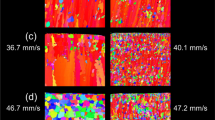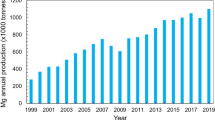Abstract
Hexagonal dislocation networks which occurred in as-annealed commercial Ti-A 50 rod and following partial extrusion under hydrostatic pressure at room temperature were studied using transmission electron microscopy. For the as-annealed condition networks were observed on the prism, basal and {2•1•1x} planes, while for the extrusion networks were only observed on the basal plane. The various stages in the development of the networks are presented and mechanisms by which they form are proposed. The self energies of the dislocation hexagons constituting the various networks are calculated using the equations proposed by de Wit and Ruff. They increase in the order: a) networks on the basal plane in the as-annealed condition, b) networks on the prism plane in the asannealed condition and c) networks on the basal plane in the partially extruded condition.
Similar content being viewed by others
References
H. M. Miekk-oja:Phil. Mag., 1966, vol. 13, p. 367.
V. K. Lindroos and H. M. Miekk-oja:Phil. Mag., 1967, vol. 16, p. 593.
V. K. Lindroos and H. M. Miekk-oja:Phil. Mag., 1968,. vol. 17,p. 119.
V. K. lindroos and H. M. Miekk-oja:Phil. Mag., 1969, vol. 20, p. 329.
V. K. Lindroos:Phil. Mag., 1971, vol. 24, p. 709.
S. Amelinckx:The Direct Observation of Dislocations, p. 312, Academia Press, New York, 1964; supplement 6 to Solid State Physics.
S. P. Agrawal, G. A. Sargent, and H. Conrad:Mater. Sci. Engr., 1974, vol. 14, p. 149.
G. A. Sargent, S. Agrawal, R. J. De Angelis, and H. Conrad:Titanium Science and Technology, vol. 3, I. Jaffee and H. M. Burte, eds., p. 1745, Plenum Publ. Corp., New York, 1972.
G. F. Pittinato and S. F. Frederick:Trans. TMS-AIME, 1969, vol. 245, p. 2299.
H. Conrad:Acta Met., 1966, vol. 14, p. 1631.
L. Rice, C. P. Hinesley, and H. Conrad:Metallography, 1971, vol. 4, p. 257.
R. de Wit and A. W. Ruff:Phil. Mag., 1967, vol. 15, p. 1065.
T. Tanaka and H. Conrad:Acta Met., 1972, vol. 20, p. 1019.
K. Okazaki and H. Conrad:Acta Met., 1973, vol. 21, p. 1117.
S. P. Agrawal, G. A. Sargent, and H. Conrad:Met. Trans., 1973, vol. 4, p. 2613.
J. P. Hirth and J. Lothe:Theory of Dislocations, p. 145, McGraw-Hill Book Co., New York, 1968.
S. Amelinckx and H. Dekeyser:Solid State Phys., 1959, vol. 8, p. 415.
Author information
Authors and Affiliations
Additional information
This paper is based on Doctoral Thesis presented in October 1973 by S. P. AGRAWAL to the Department of Metallurgical Engineering and Materials Science at the University of Kentucky.
Rights and permissions
About this article
Cite this article
Agrawal, S.P., Sargent, G.A. & Conrad, H. Hexagonal dislocation networks in titanium. Metall Trans 5, 2415–2422 (1974). https://doi.org/10.1007/BF02644025
Received:
Published:
Issue Date:
DOI: https://doi.org/10.1007/BF02644025




